As goes the price of oil per barrel, so too goes the price of gasoline and a range of petroleum-based products, including asphalt oil used for pavement applications. Although there has been an easing in oil prices lately, there’s uncertainty about the future of oil pricing, and hence the pricing of oil-based products.
The price of asphalt paving, for example, has increased sharply. It was reported in July that the price for PG-58 paving asphalt increased 2% after three consecutive increases in April, May and June. When crude was hovering at $70 per barrel, asphalt prices increased 10% in June after 4.8% and 5.3% rises in May and April.
Higher oil prices mean higher prices for asphalt, which is affecting some road repair projects. State and local transportation officials have been quoted in scores of mainstream media accounts about how the increasing cost of asphalt will hurt them. A few examples include:
- “The effect down the road could be painful both for suppliers . . . and government agencies,” the Akron (Ohio) Beacon Journal reported on June 4;
- “Drivers know they’re paying at the pump,” the Southeast Missourian in Cape Girardeau, Mo., wrote on June 24, “but they might be surprised to know they’re also paying where the rubber hits the road”; and
- “Asphalt sticker shock is creating heartburn for legions of highway chiefs, prompting many to significantly curtail the number of roads they intend to repair this season,” the Boston Globe reported on June 8.
World conflict
At press time, WorldOil.com was quoting west Texas intermediate (WTI) crude at $67.35 per barrel, down from $73.30 per barrel. Of the various classifications for oil, WTI is considered the benchmark crude oil in the U.S. Even though prices have eased, the world oil situation is still volatile.
The Energy Information Administration, the U.S. Department of Energy’s source of official energy statistics for the U.S. government, notes seven factors contributing to worldwide oil prices:
- Demand growth continues to outstrip non-OPEC supply growth;
- Non-OPEC supply has failed to meet expectations;
- Low OPEC spare capacity levels increase the demand for inventories;
- Geopolitical issues in major OPEC member countries have lowered production and increased the risk of future production disruptions;
- Worldwide refining sector bottlenecks have raised refiner margins and have implications for crude oil prices;
- Weather has disrupted supplies; and
- Available evidence suggests that increased speculative activity in oil markets is a symptom of, rather than a cause of, high oil prices.
This all leads to a bad result for agencies that use asphalt oil, whose prices have been boosted significantly by rising crude oil prices. One representative example: The average price of liquid asphalt climbed from $183 per ton in July 2004 to $359 per ton in July, according to the California Paving Asphalt Price Index produced by Caltrans.
Ed Sullivan, chief economist at the Portland Cement Association, said this trend of rising asphalt costs is not likely to go away any time soon, because the trend of increasing oil prices is not going away any time soon. In the past 20 or 30 years, he explained, the spikes in oil prices were never sustained. The market responded when people cut back on consumption, and oil prices—and the prices of things that are based on oil—eventually followed suit.
But “the world scene has changed dramatically” in recent times, Sullivan said. China and India are demanding more of the world’s oil. Unrest in the Middle East doesn’t help, either. “It’s going to be much more unlikely” that oil prices will drop significantly for a sustained period.
Asphalt availability
Not only are higher asphalt prices most likely here to stay, asphalt proponents may soon have another problem: product availability. It was reported recently that refiners are finding that “producing lighter-grade petroleum products is more profitable” than producing liquid asphalt.
Refiners that add catalytic cracking units have little crude left over for liquid asphalt. “With ultralow-sulfur emission retrofits and coker installations planned for 2008-10, fewer refiners are even offering liquid asphalt,” it was reported.
The pricing volatility, along with concerns about product availability, underscore some inherent features of concrete pavements.
“Concrete pavement has traditionally been more economical on a long-term lifetime basis,” Sullivan said. Concrete is looking more and more attractive because its front-end costs are more competitive and because the long-term prospects of asphalt are somewhat in question. Unlike asphalt, energy only accounts for 10 to 15% of the production cost of concrete.
What does the trend mean for agencies using asphalt? With limited budgets, state and local agencies are feeling the effects of rising fuel prices. Some agencies are unfortunately cutting back on projects, which has negative implications both immediately and in the future.
Pro concrete
Paying more money to accomplish less work is a losing strategy. Using thinner asphalt overlays and reverting to old grades of asphalt will not sit well with taxpayers, either.
Although the long-term cost benefits of concrete pavements have long been understood, a growing number of agencies are now seeing that both first costs and life-cycle costs favor concrete instead of asphalt.
In Kansas, the state department of transportation has officially switched four projects that were initially slated as asphalt pavement to concrete. The projects are on U.S. 54, U.S. 169 and K-18. The projects total $86 million, with $27.5 million of that being direct pavement surfacing costs, according to Todd M. LaTorella, P.E., director of engineering for the Missouri/Kansas Chapter of the American Concrete Pavement Association (ACPA).
On these four projects, asphalt pavement was initially 17 to 44% less expensive. But after re-running the costs with current-day cost information, the state found that concrete pavement was 1 to 11% less expensive, the biggest change being a 45% swing. LaTorella said KDOT also is revisiting a number of other projects where asphalt pavement had originally been selected using current-day cost information as well as “economizing” design changes promoted by the MO/KS chapter, ACPA and its members.
Traditionally, concrete pavement has always won out over the life cycle in Kansas. But now, with concrete pavement being first-cost competitive, if not less expensive than asphalt pavement, it is turning into a highly competitive situation. On two recent large projects, concrete was estimated (by KDOT) to be 7% less expensive to construct initially than asphalt pavement.
In early August, a county in Minnesota started transforming a 3.2-mile stretch of Highway 2 from asphalt to concrete. McLeod County Highway Engineer John Brunkhorst said soaring asphalt costs were a major factor in the decision. The road, about an hour west of the Twin Cities, needed work, but an asphalt fix did not make economic sense.
In Minnesota, the state has decided to put an unbonded concrete overlay on a 13.8-mile section of westbound U.S. 10. This section of road was constructed of 8-in. JRCP in 1960 with a 6-in. bituminous overlay placed in 1988, according to Perry Collins, a materials engineer with the Minnesota DOT. The existing overlay is deteriorated to the point where all of it needs removal and replacement, he said, and the state had planned for a 6-in. mill and bituminous overlay.
But asphalt prices have risen approximately 40% in that part of the state during the past year, and the state determined that an unbonded concrete overlay is now more cost effective on a life-cycle basis, considering the particular design parameters. Other benefits will be mitigated reflective cracking and less disruption to traffic over the design life, Collins said.
The situation also may be changing in Montana, according to Mark Wissinger, the state department of transportation’s construction engineer.
In Pennsylvania, an 8.5-mile section of I-99 was let in May 2006 with concrete and asphalt pavement sections included in the bid offering. The state DOT, in cooperation with the Federal Highway Administration, agreed to use a procedure where the price offerings of the bidders (the “A” component) and the future maintenance and road-user delay costs of each of the different alternatives (the “C” component) were combined to determine pavement type selection.
This is the kind of comprehensive analysis that allows the true value of concrete paving to be shown. Sure enough, the concrete pavement option, awarded to ACPA-member New Enterprise Stone & Lime Co., came in at $1.7 million under, or almost 5% less than, the equivalently designed asphalt section on a first-cost basis alone. When combining the A+C components of the bid, the concrete option will save the taxpayers 9.3% when compared with the asphalt section.
This kind of analysis would be useful in Indiana, where the DOT has been having trouble getting proper bids for road projects. The state must reject bids that come in more than 5% over estimates, according to the Fort Wayne (Ind.) Journal Gazette. As asphalt prices spike, contractors must build the cost into their bids. Those bids come in high, and the state must re-bid. This causes more delay and longer waits for much-needed construction and repair work.
Charleston, W.Va., used to put asphalt overlays on concrete streets that needed repair. But the city just let a $262,000 contract to replace damaged concrete with new concrete panels. The shift was inspired by a change in approach by city officials and by the rising cost of asphalt, City Engineer Chris Knox said. Last year, asphalt cost the city $53 per ton placed; that figure is now up to $67 a ton.
Rising asphalt costs have become a major problem for a growing number of agencies, contractors and other stakeholders. Although no one can predict the future price or availability of crude oil or asphalt oil, it is certain that the current volatility will remain a significant factor for construction seasons yet to come.


